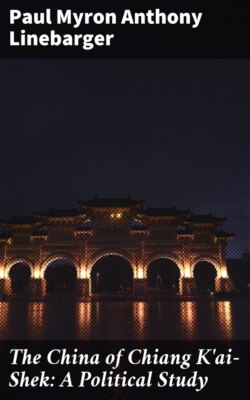Читать книгу The China of Chiang K'ai-Shek: A Political Study - Paul Myron Anthony Linebarger - Страница 26
На сайте Литреса книга снята с продажи.
The Administrative Pattern
ОглавлениеTable of Contents
Central policy-making is complicated by a trifurcation of organs—Party Headquarters, Military Affairs Commission, and Executive Yüan. For example, the nation's publicity and broadcasting services, as well as direction of the official news agencies, are under the (Kuomintang) Party-Ministry of Publicity, while the Foreign Office possesses its own publicity organs for the international relations field, and the Political Department of the Military Affairs Commission handles much domestic propaganda and agitation. The strictly governmental, permanent administrative agencies are simplified from their pre-war complexity, as the following list will show:
EXECUTIVE Yüan
Ministry of Foreign Affairs
Ministry of the Interior
Ministry of Finance
Ministry of Economic Affairs (to be reorganized)
Ministry of Social Affairs (pending)
Ministry of Education
Ministry of Communications
Ministry of Agriculture and Forestry
Commission on Mongolian and Tibetan Affairs
Commission on Overseas Chinese Affairs
National Relief Commission
Ministry of War (also under the Military Affairs Commission)
Material and Resources Control and Supervision Ministry (pending; status uncertain)
JUDICIAL Yüan
Ministry of Justice
CONTROL Yüan
Ministry of Audit
EXAMINATION Yüan
Ministry of Personnel
Examination Commission
The Ministries outside the Executive are well adapted to their respective Yüan, although Americans may think the Ministry of Justice misplaced. The Executive Ministries form the heart of the administrative system, immediately below the cabinet (Executive Yüan Meeting). The Party scaffolding is to be torn down with constitutionalization; the military scaffolding, with peace. The administrative organs at the center will then bear the real burden of nourishing and protecting the nation which now they help to create.
Despite strong Chinese imprints, the central administrative agencies are organizationally more Westernized than the policy-making agencies. For this reason, and because administrative emphasis is on matters economic (outside the scope of the present work), the reader is referred to other sources for a detailed appraisal of the work of the ministries. Particularly fortunate is it that China Shall Rise Again, partly written and partly edited by Madame Chiang K'ai-shek,[10] has been published, including authoritative statements by the leading ministers on the work of their respective ministries.
The Ministries (pu) may be classified into three groups, according to the major tenor of their work: political, social and cultural, and economic. Military defense through economic development and social reconstruction remains their common goal, however divergent the approaches.
